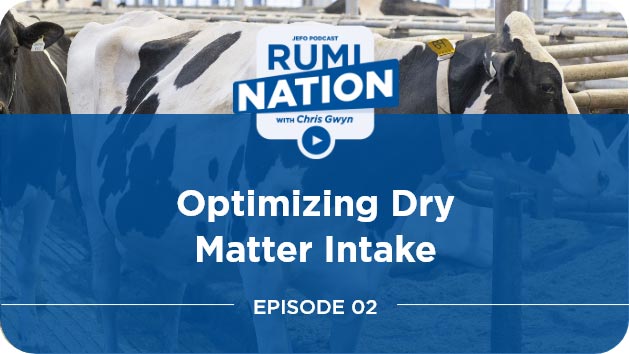RumiNation | S03 : E01
Amino Acids, Proteins and Milk Production
Brought to you by Jefo Nutrition
Share now!
Did you enjoy this episode?
Share now!
Our guest - Dr. Hélène Lapierre
Helene Lapierre is a research scientist for Agriculture and Agri-Food Canada’s Sherbrooke Research and Development Centre. Her research focuses on factors that influence the efficiency of nutrient use in the production of milk and milk components, studying the intermediary metabolism of dairy cows, and improving the transfer of protein from dairy rations into milk protein to lower production costs.

Timestamps & Summary
2:00
Dr. Lapierre, could you expand perhaps for the audience on how you arrived at looking at nitrogen and amino acid requirements of dairy cows?
Dr. Hélène Lapierre
Well, it has been a long road. And I did my bachelor’s degree at Laval University. Then I went for a master but I was still not decided. I went to work in finance for a while and got attracted back into research. I did a PhD at Sherbrooke University in animal physiology, and then get the opportunity to work with Henry Tyrrell and Chris Reynolds at the USDA in Beltsville, Maryland. Then I got a job at the Research and Development Center.
04:35
You said 30 years in amino acid research has come a long way. And as you mentioned, learning techniques and discovering the techniques were probably a key part of that.
Dr. Hélène Lapierre
Absolutely. That was a combination of different techniques. The purpose was to look at what was going on within the animal. So we had different techniques, we could use nutrients that were labeled with stable isotopes, which are different from the radioactive isotopes. That allowed us to follow the fate of this amino acid that the cow was eating. Was it going towards milk? Was it going to be oxidized? Was it going to the muscle? What was the trade between the different amino acids in terms of nitrogen shifts? So, yeah, I can talk for the whole afternoon if you want!
05:52
If a nutritionist asks you, what are the key points that they need to think about? What would you relay to them from that?
Dr. Hélène Lapierre
We really wanted to start with what we thought were the biological concepts that should be underlying all those estimations. So the supply of protein was being revised. To be more specific, the protein that the cows are digesting, more than half are from microbial protein, the other 35% will be from the dietary proteins that are not degraded within the rumen. And about 15% of what’s arriving at the entrance of the small intestine will be just what we call endogenous proteins, that are being secreted by the animal within the gut lumen. There was a computer vision of each of those different factions. So microbial crude protein, that was defined based on the nutrient that we digested across the whole tract in the previous system, which is not truly biology because it’s occurring within the rumen. We don’t want to look at what’s occurring across the whole track. So now it’s really focused on how much starch is being degraded into the rumen, how much NDF and nitrogen is degraded.
10:18
How well these models are predicting the needs of high producing cows that we see more and more abundantly in the industry? Are we predicting those requirements well? And is there anything different that the new model does to adjust for that?
Dr. Hélène Lapierre
Well, the prediction of nicotine yield is totally different from what it has been. And in addition, when we develop those models, actually, we do use published values in the literature. But these are cows that have been there before, they are not cows that we want to feed now in the future. So to adjust for that, what we did is that we included what we call the rolling herd average, which is basically the average meal protein yield for a 305 day of production. So we have to input that number into the model. And that changes, just through maths, the different coefficients predicting meal protein yield, so that way, it’s being taking into account the fact that the model has been built with cows that have been there, but we focus on the cows that we want to feed in the future. So this is quite a new approach for this model.
11:57
Could you give us an update on your thoughts with that particular amino acid?
Dr. Hélène Lapierre
We began to be interested in that amino acid maybe 15 years ago. And when we looked at the literature, at that time, we could find a requirement, that was as a proportion of metalloprotein. But this number varied a lot among the different studies that had been conducted, and we wondered why. So then we conducted other works with cows that were fed with corn silage. And we found the consumers ask for animal production that does have a lower footprint on the environment, they really want to see the producers and nutritionists to decrease the pollution that we do have with animal production, including the dairy sector. And actually, what we realized is that, when you want to decrease the protein concentration of a diet, what happens is that the proportion of what is coming from the microbial protein is increasing. About 50% of the protein digested by the cows are of microbial origin. But if you want to decrease the crude protein that you feed the animal, then this proportion might increase to 60–65%. Although we have learned in our classes that microbial protein has a very good profile of amino acid, if you really look at the numbers, histidine in the microbial protein is lower than in the feed ingredients. So when you decrease the total amount of protein that you feed, you increase the proportion of microbial, so you decrease the quantity of histidine at the higher rate, then you decrease what is being fed for the other amino acid. […]
16:04
What would be your take-home recommendations related to amino acid balancing?
Dr. Hélène Lapierre
I would say to really balance their ration for amino acid. It has been working for poultry, it has been working for pigs, there is no reason why it wouldn’t be working for the ruminants. Obviously, the challenge is larger because we need to determine what’s being supplied through the microbes to what’s not being degraded within the rumen. But I think we have made really huge progress over the last two decades to develop rumen submodels. So really, to focus and forget a little bit about protein metabolizable protein, and look for essential amino acids. And please do not balance diet for crude protein. It is like so outdated.






